This website has been archived from TrainWeb.org/girr to TrainWeb.US/girr.
This website has been archived from TrainWeb.org/girr to TrainWeb.US/girr.
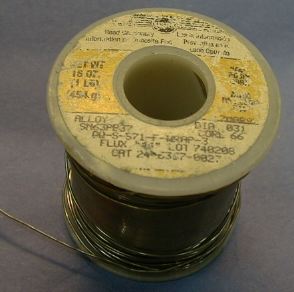 While it is possible to do some wiring without soldering
connections, soldering is the preferred approach. Proper soldering
is easy with the right tools and techniques. One item that is
critical is the right solder. This roll of SN63 rosin core solder
can be used for any kind of joint on a model railroad. DO
NOT use the environmentally friendly lead free solders,
they don't work worth a damn. Even in carefully controlled
industrial conditions, lead free solders produce inferior
connections. As much as the politicians backed by environmentalists
would like to, they can't legislate metallurgy.
While it is possible to do some wiring without soldering
connections, soldering is the preferred approach. Proper soldering
is easy with the right tools and techniques. One item that is
critical is the right solder. This roll of SN63 rosin core solder
can be used for any kind of joint on a model railroad. DO
NOT use the environmentally friendly lead free solders,
they don't work worth a damn. Even in carefully controlled
industrial conditions, lead free solders produce inferior
connections. As much as the politicians backed by environmentalists
would like to, they can't legislate metallurgy.
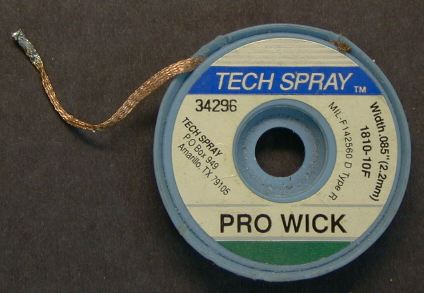 Sometimes after you have managed to get some
solder on a joint, you find that you have to take the joint apart
and get the excess solder off. Solder Wick is a rosin impregnated
copper braid that is used to wick off excess solder by capillary
action. Obviously, this is a single use tool. Once the wick is
saturated with solder, it is clipped off and discarded.
Sometimes after you have managed to get some
solder on a joint, you find that you have to take the joint apart
and get the excess solder off. Solder Wick is a rosin impregnated
copper braid that is used to wick off excess solder by capillary
action. Obviously, this is a single use tool. Once the wick is
saturated with solder, it is clipped off and discarded.
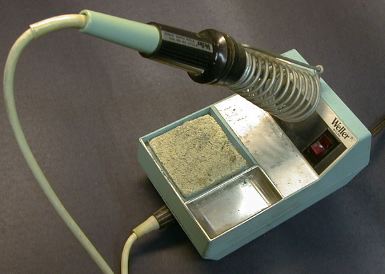 For most work, you
should use a temperature controlled soldering station. These are
fairly expensive items, ranging to from $60 up, but they are
necessary. A cheap soldering iron will usually run too hot and the
tips don't last. Soldering guns are too clumsy, the tips are too
big, and the run too hot for fine wiring. This soldering station
regulates temperature by changing the tip, other kinds have a
temperature adjustment. Most work can be done at 700 degrees F.
For most work, you
should use a temperature controlled soldering station. These are
fairly expensive items, ranging to from $60 up, but they are
necessary. A cheap soldering iron will usually run too hot and the
tips don't last. Soldering guns are too clumsy, the tips are too
big, and the run too hot for fine wiring. This soldering station
regulates temperature by changing the tip, other kinds have a
temperature adjustment. Most work can be done at 700 degrees F.
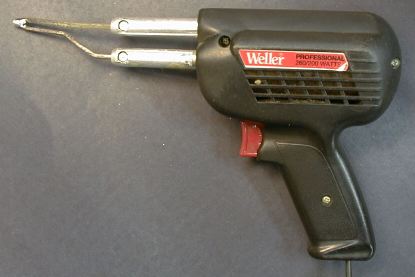 For heavier work, such as track soldering, a
larger heat source is necessary. This Weller 250 watt soldering gun
is the ticket. You won't be able to use it for much else, but if
you solder track, you'll need something like it.
For heavier work, such as track soldering, a
larger heat source is necessary. This Weller 250 watt soldering gun
is the ticket. You won't be able to use it for much else, but if
you solder track, you'll need something like it.
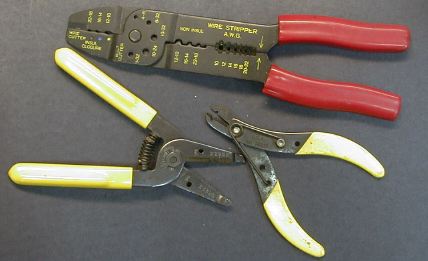 To strip insulation on
wire, you need a pair of wire strippers. Between them, these tools
will strip wire from 30 GA to 10 GA. The one with the red handles
will also crimp lugs and cut screws. There are fancier strippers
available, but they really aren't necessary for modeling work. The
better, and more expensive, semiautomatic or thermal strippers will
tend to nick wire less often.
To strip insulation on
wire, you need a pair of wire strippers. Between them, these tools
will strip wire from 30 GA to 10 GA. The one with the red handles
will also crimp lugs and cut screws. There are fancier strippers
available, but they really aren't necessary for modeling work. The
better, and more expensive, semiautomatic or thermal strippers will
tend to nick wire less often.
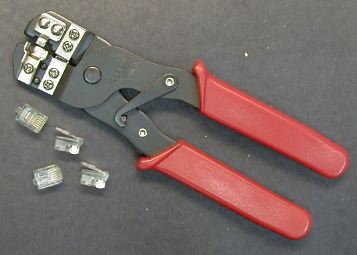 This tool is used to crimp on the RJ-11
modular telephone connectors on ribbon cable. This is a quick and
easy process. You'll need this tool if you use one of the DCC
systems that uses RJ-11 connectors in their throttle busses. Other
tools are available to crimp on the larger RJ-45 connectors used in
10BaseT Ethernet installations.
This tool is used to crimp on the RJ-11
modular telephone connectors on ribbon cable. This is a quick and
easy process. You'll need this tool if you use one of the DCC
systems that uses RJ-11 connectors in their throttle busses. Other
tools are available to crimp on the larger RJ-45 connectors used in
10BaseT Ethernet installations.
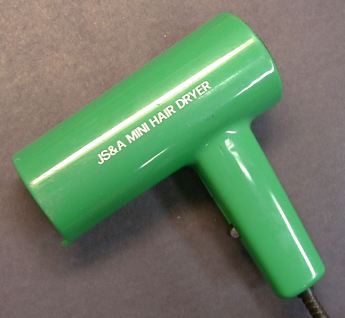 Once a connection is made, it should be insulated
with heat shrink tubing. This tubing will shrink around a
connection when heated with very hot air. An ordinary 1200 watt
hair dryer is usually sufficient for light duty work. you should
buy some tubing in several small sizes, 1/16", 3/32" and 1/8"
diameter tubing will cover the majority of requirements.
Once a connection is made, it should be insulated
with heat shrink tubing. This tubing will shrink around a
connection when heated with very hot air. An ordinary 1200 watt
hair dryer is usually sufficient for light duty work. you should
buy some tubing in several small sizes, 1/16", 3/32" and 1/8"
diameter tubing will cover the majority of requirements.
Do not try to use electrical tape to insulate connections. The stuff will eventually unravel or slide off the connection.
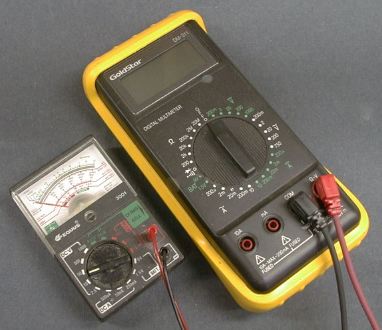 To do basic troubleshooting, you'll need a couple of
multimeters. Often two measurements have to be made at once, so
having two meters is handy. One can usually be a real cheap meter
like the sub $10 meter on the left. The other should be a good
digital meter. Try to find one with 10 amp AC and DC current ranges
in addition to the normal DCV, ACV and resistance ranges. 3-1/2
digit precision is adequate for hobby work. I found this meter on
sale for less than $30.
To do basic troubleshooting, you'll need a couple of
multimeters. Often two measurements have to be made at once, so
having two meters is handy. One can usually be a real cheap meter
like the sub $10 meter on the left. The other should be a good
digital meter. Try to find one with 10 amp AC and DC current ranges
in addition to the normal DCV, ACV and resistance ranges. 3-1/2
digit precision is adequate for hobby work. I found this meter on
sale for less than $30.
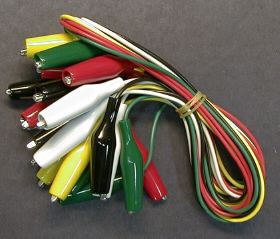 A dozen or so small alligator clip leads are
essential for a test bench to make test connections. You can find
leads like this at Radio Shack or other electronics stores.
A dozen or so small alligator clip leads are
essential for a test bench to make test connections. You can find
leads like this at Radio Shack or other electronics stores.
© 1999 George Schreyer
Created Dec 4, 1999
Last Updated Dec 4, 1999